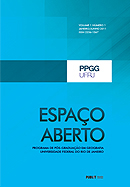Mapping of Age of Secondary Forests: Case Study in Rio de Janeiro State
DOI:
https://doi.org/10.36403/espacoaberto.2022.49599Keywords:
Land Use Change Detection, Time-series, LandTrendr, Remote SensingAbstract
Mapping and monitoring the growth of secondary forests is critical for effective land management. In addition to detecting changes in vegetation cover through remote sensing techniques, it is essential to identify how regeneration varies in each portion of a territory. The main objective of this paper is to methodologically contribute to characterizing secondary forests of Rio de Janeiro state with regard to age, magnitude and occurrence in relief. Forest recovery is more frequent in northern Rio de Janeiro, possibly associated to agricultural land abandonment. The oldest secondary forests are located near the coast in zones of flatter and lower relief (Região dos Lagos) while newer secondary forest is found in inland regions where the relief is more undulating and higher (Região do “Vale do Café” and Região Serrana).


